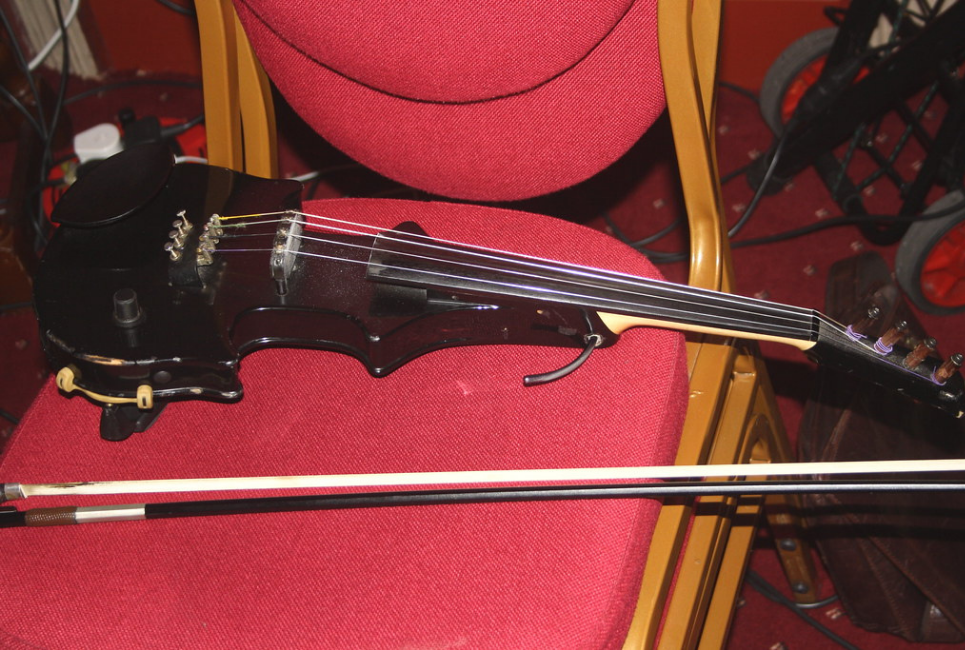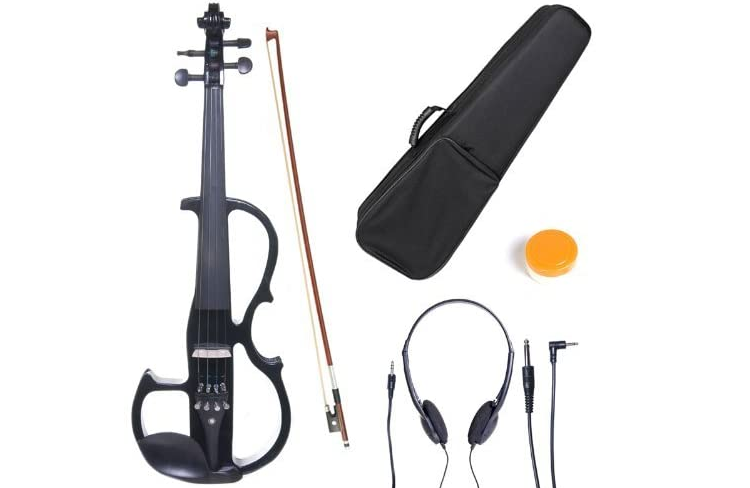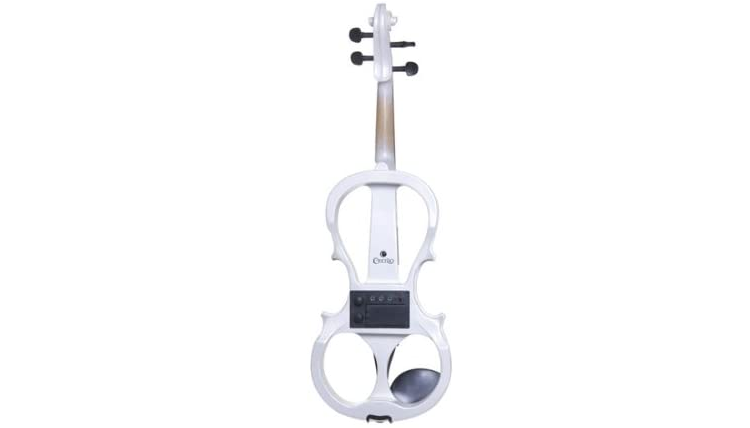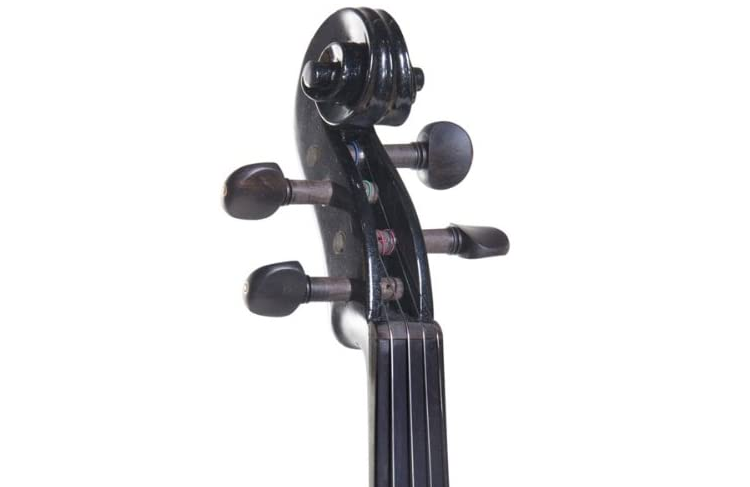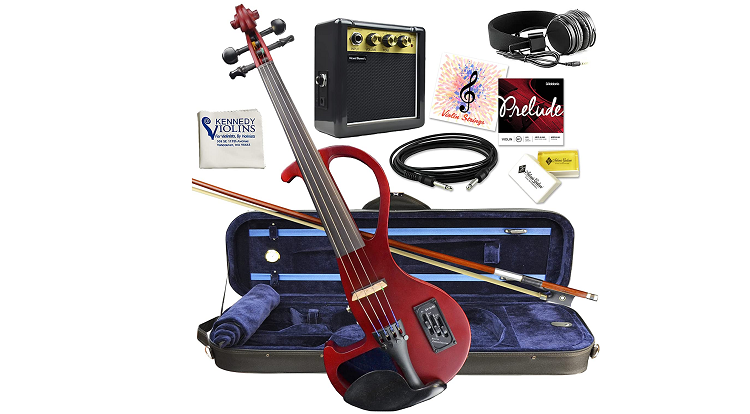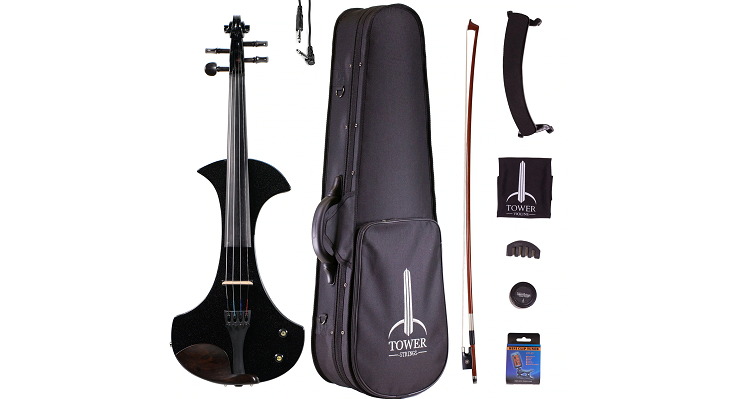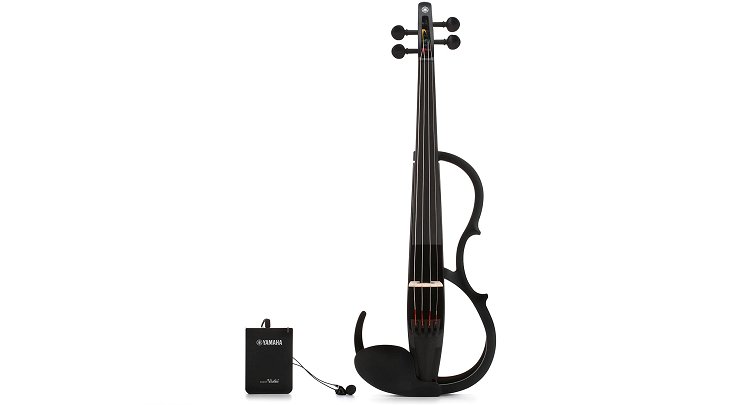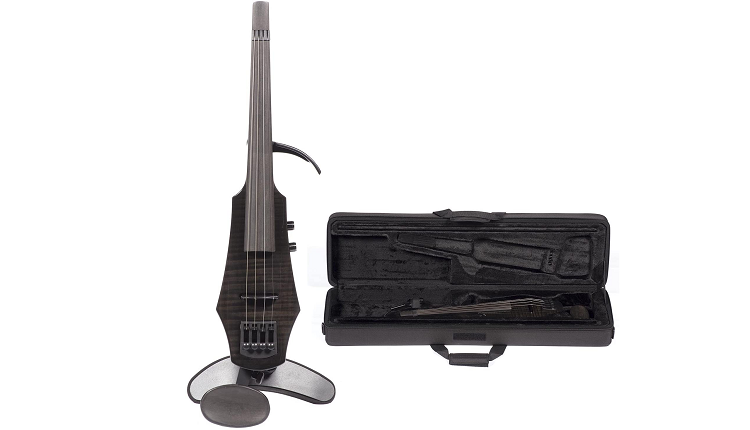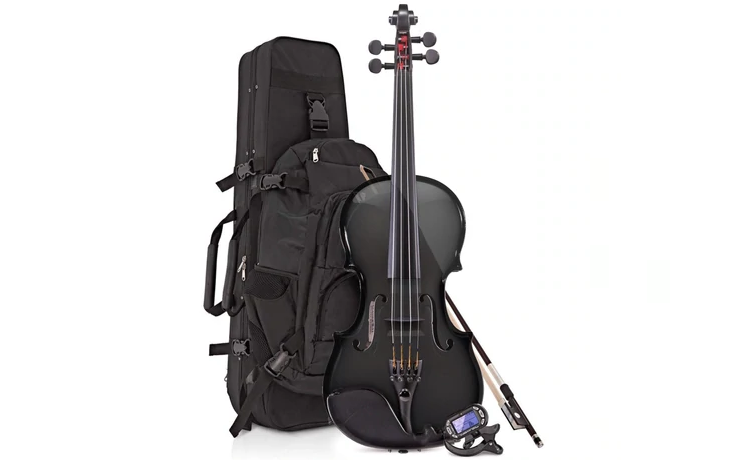- Mendini MV300: An Honest Breakdown and Review - April 6, 2022
- Cecilio Viola Review and Guide: 3 Violas, Which is the Best? - January 21, 2022
- Cecilio Electric Violin Review and Guide: A Silent Practice Violin! - January 20, 2022
Acoustic violins, much like an acoustic guitar, are pretty versatile; they can play about any music you throw at them. Still, a new world opens up when you add electronics into the mix. Electronics allow a musician to distort, amplify, manipulate and loop sounds and music to create various effects and complete tracks.
This is attractive, especially for contemporary musicians who might focus on both the music and a good show. Electric violins are durable, excellent for outside venus, and have high energy experiences.
As a contemporary musician myself, I find a lot of joy in playing with my electronics, especially my electric violins. I’ll never forget the first time I plugged my new electric violin into an amp and hit the overdrive button. Hearing the full distorted effect of Emilie Autumn’s Face the Wall coming out of my fingers was an amazing feeling.
The look of awe on my husband’s face was even more pleasing (he talked about this instance for weeks). Overdrive is just one of the many effects, and that’s by far the easiest one.
Cecilio would be missing a huge chunk of their market if they didn’t include an electric violin in their lineup, especially since they cater to adult learners more than kids. In fact, they don’t just have one style of an electric violin; they have 4, plus 2 left-handed versions and an acoustic-electric. So let’s check it out!
Pros, Cons, and Bottomline
Cecilio makes a lot of lower-quality instruments, and their electric violin fits into this lineup well. This doesn’t mean it doesn’t hold value or isn’t a good instrument. As far as electric violins go, this one gets the job done. It’s also inexpensive and priced accordingly.
There is something for everyone here with 4 different body styles to choose from (2 if you are left-handed) and 5 colors. My overall opinion is that this electric violin is pretty basic. It’s great for a player who wants to expand their horizons.
Still, it doesn’t want to spend the money on a Yamaha, NS Designs, or Auro electric violin. It’s also great for a student who has and plays an acoustic violin daily but needs something extra to practice with at night or during quiet periods. If you are a performer or looking for a recording instrument, I have some suggestions below!
An electric violin is not for you if you are a new student. Students should always start with an acoustic violin to learn all of the nuances of playing the violin that an electric violin doesn’t replicate, like tone, projection, and resonance.
Pros
- Perfect entry-level electric violin
- Pre-amp allows for silent practice with headphones via a 9V battery
- Can be painted or customized if you want to jazz it up. I use stickers on my electric violin.
- Great prop violin.
- Easy to set up thanks to the pickup
Cons
- Cheap accessories
- Not suitable for performing or recording
- Poor cable jack placement and controls
- Will need a new bow and strings right away
- No info on the type of pickup used
All About Electric Violins
Acoustic violins get their tone, projection, and resonance from the violin’s tonewoods, shape, and soundpost. Of course, other aspects influence the violin’s tone, like the strings, bridge shape, climate, and the player’s skill level.
An electric violin gets its tone and projection from the electronics or pickup that is included. While some electric violins are shaped like an acoustic and even have F, holes.
Most electric violins have a solid body made out of any number of tonewoods. With an added pickup, the violin can now be plugged into an amp or PA system; this is where your tone and power will come from, not the instrument itself. From there, you can manipulate and distort it in any number of ways.
In general, electric violins produce a clear and bright tone. Some more expensive violins will have a more nuanced or powerful tone. Still, overall I find it empty regardless of the price. This is where effects come in handy; a little reverb and your electric violin will have a fuller and more powerful sound that is more fun to play on.
The construction can vary, from a simple cut-out violin shape to something with no pegs or carved in a crazy shape. This is where luthiers get to be extremely creative and come up with the wackiest ideas they can think of. This is also why some violins require being strapped on instead of shoulder rest.
The tonewoods can be made from anything, but maple and spruce are still very popular. The violin will still have a fingerboard that is typically made from ebony. You can also get an electric violin with fretted fingerboards, reminiscence of an electric guitar. Everything else about an electric violin is pretty nonstandard; they may or may not have chin rests.
The fittings can vary widely, and some will even have built-in shoulder rests. Some violins will have 5 or even 7 strings; others are midi compatible. There really is no end in sight for the creativity found in these instruments.
The Electronics
The electronics in an electric violin can range from a simple passive piezo pickup to an active pickup with a pre-amp. Many inexpensive electric violins have a pre-amp and a pickup installed.
This allows the player to play almost silently using headphones, great for small or shared spaces like apartments or dorms. Higher-end electric violins may have just a passive pickup like the Yamaha YEV, which requires an amp or PA system.
Electric-only violins will have a piezo pickup of some sort since they don’t have F-holes for a soundhole or F-hole pickup, which directly captures vibrations from the F-holes. The pickup can attach in a variety of ways. I typically see pickups installed under the bridge, but they can also be installed on it.
The violin will have at least one output jack for an amp; many also have an input jack and a headphone jack. These should be located somewhere out of the way; I like them on the sides where I can easily swing the cord behind me, so it’s out of the way.
Suppose tone, bass, or volumes controls are present. In that case, I like them on top of the body, so they are easily adjustable, the sides are also acceptable.
Our acoustic friends haven’t been forgotten about either. While micing a violin is probably the easiest way to amplify its sound, it doesn’t produce the best sound, and feedback is an issue. You can buy removable pickups with an output jack that clamps onto the violin, with the pickup sitting in the F-Hole, or one that clamps directly onto the bridge.
You can also have permanent pickups installed by a luthier, but for an acoustic violin, this looks pretty drastic. It would likely harm the value and looks of the violin. I’d instead buy an acoustic-electric violin if I needed something this intense. Especially since many very durable alternatives won’t be affected by weather or venue choice with this option.
Cecilio Electric Violin Review
Cecilio’s electric violin is an entry-level violin that is perfect for silent practice and the growing musician, and that’s about all it is suitable for. For the price point, it is also precisely what I would expect.
It rivals similar electric violins with the same price point from more reputable retailers. However, for about 100 dollars more, you can acquire a more excellent entry-level electric violin that will satisfy all of the criteria.
Let’s Start with the Things I Like About this Violin
There are 4 styles to choose from; styles 3 and 4 are my favorite because they deviate from the norm. While styles 1 and 2 are very traditional electric violin shapes. Left-handed folks are limited to the conventional styles 1 and 2. Still, these violins come in 5 different colors, black, blue, mahogany, yellow maple, and white. The mahogany is a deep red color that looks very nice, but I also love white and black.
The violin’s body is made from solid maple, and the fingerboard, tailpiece, and fittings are made from ebony. The tailpiece has 4 removable fine tuners, which are great if they break and need to be replaced. The pickup is located under the bridge, making set up a breeze. The pre-amp is powered by a 9Volt battery, so you can practice quietly when needed.
Now for what I Don’t Like
They placed the pre-amp, jacks, and tone controls in the worst possible location, on the back of the violin. The pre-amp battery cover starts right where your shoulder ends when holding the violin.
Meaning the jacks are just an inch or so above your shoulder. This means you can’t adjust the tone or volume easily, and the cord now dangles underneath you and is easy to trip on.
You can remedy this by switching up the output cord to an angled one, but I still find this frustrating; additionally, the headphone jacks are also underneath, which is rather annoying when practicing silently.
Along with poorly thought outplacement, the actual electronics leave a lot desired. They haven’t mentioned what brand or even kind of pickup or pre-amp is used. It’s likely something bought cheaply from a site like Aliexpress.
Cheap electronics won’t produce the best sound. They will be overly bright and incredibly tinny. They are also liable to failure; while this violin has a year-long warranty, that’s probably about how long the electronics will last with regular use.
The output, input, and headphone jacks are all 1/8 inch instead of 1/4 requiring an adapter. A 1/8 headphone jack makes a lot of sense, but a 1/8 output jack does not since I’m not aware of any PA or amp that uses that size of jack.
If there are any, they certainly aren’t common. However, I imagine the makers assumed most people wouldn’t be using this with an amp instead of headphones.
Speaking of headphones, the ones included are garbage. Which you can tell pretty clearly from the listing. You get a complete but small outfit with a basic case, bow, and rosin.
Many of the usual Cecilio accessories are missing, like an extra bridge and poorly made strings. The overall tone is also pretty empty and bright. It’s typical of an entry-level electric violin and would be helped along quite a bit with some effects.
Can I Make the Cecilio Electric Violin Sound Better?
While you may never receive the same starting tone as a more expensive electric violin, there are a few things that you can do to spruce up both the overall tone and the playability of this violin.
My first recommendation is to seek out a new bow and a new set of strings. If you’ve heeded my warnings and only purchased this after playing for a while, you will most likely have a half-decent bow already. Suppose you are in the market for a new bow. In that case, I recommend an inexpensive carbon fiber bow from Fiddlershop or Cadenza. These durable and well-made bows pair great with electric and acoustic violins.
You can throw many strings you want on this violin, but I recommend sticking with steel core strings or lower-end synthetic strings. NS Designs has its own string brands by D’Addario made for electric violins.
These strings are bright, responsive, and hold their tune really well. They are a pretty great blank slate for adding your own effects on top. I’ve also used Fiddlershop branded synthetic strings on my electric violin and liked the overall tone. It wasn’t as bright as the NS Designs ones, which suited my preferences more.
Lastly, if you use this mostly with the pre-amp, get some decent headphones and rechargeable batteries. Your ears deserve to be comfortable while you practice, and you’ll spend a fortune on batteries otherwise. This violin isn’t worth expensive accessories or strings. The more money you put into this violin, the better the violin you could have purchased.
My Favorite Electric Violin Alternatives
Top Pick – Bunnel Electric Edge from Kennedy Violins
The Bunnell Electric Edge is my favorite pick for its price, quality, and included accessories. This violin is made from solid maple with an ebony fingerboard and a piezo ceramic active pickup.
You can easily play with headphones using a 9volt battery for silent practice. The tone and volume sliders on the front of the violin and the 1/4 output jack and 1/8 headphone jack are conveniently located on the side of the violin, so the cord can easily be placed behind you.
The tailpiece is Wittner style with 4 built-in fine tuners, and the violin comes strung with Prelude strings which are great steel core strings. The outfit comes with an upgraded case, Guiliani brazilwood bow, and rosin.
Along with a mini amp and cord, decent quality headphones, and extra strings. While it’s a little more bit more expensive compared to Cecilio, you get everything you need to get started in a much higher quality package.
Budget – Tower Strings Electric Pro Violin
The Tower Strings Electric Pro violin outfit can only be found at Fiddlershop. This is my current electric violin, and I love it a lot, but I would have gotten the Bunnel Electric Edge if I had a do-over.
Like most electric violins of this price range, the violin is made from solid maple with an ebony fingerboard and an active pickup powered by a 9-volt battery for silent practice.
The tailpiece is Wittner style with 4 built-in fine tuners, and the strings are steel core, typically Prelude. The biggest downside is the location of the headphone jack, which is underneath the violin where the shoulder rest goes. The reason I would have gotten the Bunnel is for the price.
I could have gotten an amp and a violin with jacks that weren’t in annoying locations. However, I went with the Tower Strings because I didn’t know a lot about Kennedy violins, and I had already had an amp at the time. With further research, the Edge is more attractive to me now.
Performing – Yamaha YSV104
Suppose you are planning on taking your electric violin on stage. In that case, you will want to spend a decent bit more on a quality violin that will give you better sound. The Yamaha YSV104 is an entry-level Yamaha electric violin. Yamaha is known for making various band and woodwind instruments, so it makes sense that they would venture into the world of violins.
They’ve also become very popular; almost every contemporary violinist I follow has played a Yamaha at some point or another. Lindsey Stirling is the most notable, having teamed up recently to produce an acoustic violin.
This violin is made from solid maple and uses a piezo pickup installed on the bridge with a built-in pre-amp for silent practice. Interestingly, the fingerboard is made from composite material, which I’ll pass; composite is very durable and won’t create issues on an electric violin.
Additionally, the violin does have a resonance chamber to create a better, more nuanced sound. However, it can’t quite replicate an acoustic violin. This is an excellent choice for someone who needs a more professional electric violin. Still, it keeps in my mind not only does it have a higher price tag, but it also doesn’t come with any accessories or a case.
Funky – NS Designs WAV 4 String
NS Designs pulled out all of the stops when they designed this violin and completely rethought the entire design by eliminating the pegbox, scroll, and pegs and making the tuning system mechanical. If you ever heard of or perhaps used geared pegs, which work like guitar pegs to tune a string instead of friction, then you’ll be familiar with the mechanics.
You will insert your strings backward with the top ball end instead of connecting to the tailpiece. The other end will be threaded through the tailpiece, and you’ll use the fine tuner to tune.
In addition to the funky design, the Polar Pickup Passive System is perfect for a natural but powerful sound. Still, it doesn’t require an amp for full use. The shoulder rest is attached to the violin and easily adjustable, and the chin rest is custom.
Unlike the Yamaha, this violin does come with a nice case that has room for two bows and extra gear, including cords. If you want a passive pickup, then this is a great choice!
Honorable Mention- Glasser AEX Carbon Composite Acoustic-Electric
I couldn’t pass up a chance to mention this weird little violin. This isn’t the first Carbon Composite on the market; that honor goes to Mezzo Forte. But it is the first affordable carbon composite violin. For under $900, you get one of the most durable violins on the market, under $1500 for the whole outfit.
This violin won’t break if dropped, it can be played in the rain, warm or cold climates, and humidity won’t affect it. It’s great for a traveling musician.
Its classic violin design and Bartolini electronics mean you can play it independently without an amp, batteries, or headphones. Or you can play it hooked up to a PA system or an amp. The Glasser Swordtail pickup system is an exciting placement in the chin rest.
It’s available in nine different colors and comes with geared Planetary Pegs from Knilling and fine tuners for extremely easy tuning. The only downside is that the tone doesn’t project well as an acoustic violin, but it’s great if you are on the go and need something durable to play.
Many musicians use Carbon Composite violins for shows when they travel or in music videos due to their durability. If you buy the outfit, you will receive a backpack case, carbon fiber bow, and tuner along with your instrument.
FAQ
Answer: No, but they are incredibly quiet and can’t be heard easily through thicker walls with closed doors as most of the sound is coming through the headphones. However, this won’t allow for great tone or practice; it’s only suitable for late at night or apartment practice. It won’t substitute practicing with your acoustic violin.
Answer: Active pickups require extra power and have a more dynamic sound, giving the player more control. Passive pickups don’t require extra power or headphones. Still, they don’t produce a dynamic sound and rely entirely on an amp. Additionally, they are prone to interference.
Answer: If you are wondering if you can use your favorite strings on your electric violin, the answer is yes. However, gut strings might be an interesting combo. NS Designs by D’Addario are the only strings made specifically for the electric violin; otherwise, steel strings are used quite often. Synthetics are also pretty popular.
Final Thoughts
Electric violins are amazing and versatile instruments. They can be used for silent practice, amazing shows full of effects, or simple looping tracks for videos. The Cecilio electric violin is a great entry-level violin, but it won’t outplay electric violins of a higher caliber. Still, it’s an excellent pick for silent practice or learning about peddles and effects.
Still, for a little more, you can get a better violin in a better bundle that will have you completely set with the Bunnel Electric Edge. For performances, the Yamaha or NS Designs is a great pick. The Glasser AEX will offer durability and stability for traveling professionals while not breaking the bank.
Looking for more interesting readings? Check out:

